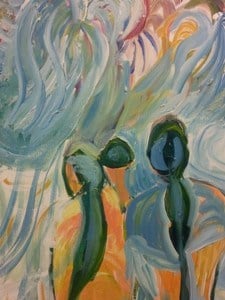Parkinson’s experts across the world have been reporting a remarkable phenomenon — many patients treated with drugs to increase the activity of dopamine in the brain as a therapy for motor symptoms such as tremors and muscle rigidity are developing new creative talents, including painting, sculpting, writing, and more.
Prof. Rivka Inzelberg of Tel Aviv University’s Sackler Faculty of Medicinefirst noticed the trend in her own Sheba Medical Center clinic when the usual holiday presents from patients — typically chocolates or similar gifts — took a surprising turn. “Instead, patients starting bringing us art they had made themselves,” she says.
 Inspired by the discovery, Prof. Inzelberg sought out evidence of this rise in creativity in current medical literature. Bringing together case studies from around the world, she examined the details of each patient to uncover a common underlying factor — all were being treated with either synthetic precursors of dopamine or dopamine receptor agonists, which increase the amount of dopamine activity in the brain by stimulating receptors. Her report will be published in the journal Behavioral Neuroscience.
Inspired by the discovery, Prof. Inzelberg sought out evidence of this rise in creativity in current medical literature. Bringing together case studies from around the world, she examined the details of each patient to uncover a common underlying factor — all were being treated with either synthetic precursors of dopamine or dopamine receptor agonists, which increase the amount of dopamine activity in the brain by stimulating receptors. Her report will be published in the journal Behavioral Neuroscience.
Dopamine is involved in several neurological systems, explains Prof. Inzelberg. Its main purpose is to aid in the transmission of motor commands, which is why a lack of dopamine in Parkinson’s patients is associated with tremors and a difficulty in coordinating their movements.
But it’s also involved in the brain’s “reward system” — the satisfaction or happiness we experience from an accomplishment. This is the system which Prof. Inzelberg predicts is associated with increasing creativity. Dopamine and artistry have long been connected, she points out, citing the example of the Vincent Van Gogh, who suffered from psychosis. It’s possible that his creativity was the result of this psychosis, thought to be caused by a spontaneous spiking of dopamine levels in the brain.
There are seemingly no limits to the types of artistic work for which patients develop talents, observes Prof. Inzelberg. Cases include an architect who began to draw and paint human figures after treatment, and a patient who, after treatment, became a prize-winning poet though he had never been involved in the arts before.
It’s possible that these patients are expressing latent talents they never had the courage to demonstrate before, she suggests. Dopamine-inducing therapies are also connected to a loss of impulse control, and sometimes result in behaviors like excessive gambling or obsessional hobbies. An increase in artistic drive could be linked to this lowering of inhibitions, allowing patients to embrace their creativity. Some patients have even reported a connection between their artistic sensibilities and medication dose, noting that they feel they can create more freely when the dose is higher.
Therapeutic value
Prof. Inzelberg believes that such artistic expressions have promising therapeutic potential, both psychologically and physiologically. Her patients report being happier when they are busy with their art, and have noted that motor handicaps can lessen significantly. One such patient is usually wheelchair-bound or dependent on a walker, but creates intricate wooden sculptures that have been displayed in galleries. External stimuli can sometimes bypass motor issues and foster normal movement, she explains. Similar types of art therapy are already used for dementia and stroke patients to help mitigate the loss of verbal communication skills, for example.
The next step is to try to characterize those patients who become more creative through treatment through comparing them to patients who do not experience a growth in artistic output. “We want to screen patients under treatment for creativity and impulsivity to see if we can identify what is unique in those who do become more creative,” says Prof. Inzelberg. She also believes that such research could provide valuable insights into creativity in healthy populations, too.

